Originally published on Mohinga Matters
Since the 2021 military coup, widespread violence, internal displacement, chaos, and human despair has set off a disastrous refugee crisis in the region. Thousands of Myanmar people have fked their homes to neighboring countries, with many seeking asylum in Bangladesh and India.
Over 50,000 civilians have fled from Chin State and Sagaing Region into India’s northeastern states of Mizoram and Manipur. This influx of refugees has created a simmering crisis on India’s border with Myanmar. Human Rights Watch states that around 40,000 Rohingya live in India as refugees or asylum seekers. In India, some Rohingya have settled in New Delhi, while others have set up makeshift homes in the states of Uttar Pradesh, Haryana, West Bengal, and Kashmir.
While India condemned the coup and the ongoing violence in its early stages, two years into the current military regime, and India’s government has maintained a delicate balancing act for strategic geopolitical interests, allowing refugees into the country but refraining from placing political pressure on the junta. A U.N. report reveals that Indian government-owned companies and private firms are supplying arms and raw materials to the Myanmar regime. According to the report, India-based companies, including state-owned entities, have shipped at least $51 million USD worth of supplies to the military.
In the past, India has opened doors and provided concerted humanitarian assistance. For example, in the 1980s then-Prime Minister Indira Gandhi, and subsequently her son Rajiv Gandhi, backed the pro-democracy protests in Myanmar, cutting off ties with the military. Students and activists fleeing military violence were welcomed with open arms by the Indian public. When the leader of the National League for Democracy (NLD) party, Aung San Suu Kyi was placed under house arrest, there was popular support for her in India. Yet, by 1991, when Narasimha Rao became Prime Minister of India, New Delhi changed its policy. Realizing that China was stepping into the picture, Narasimha Rao decided to engage with the military in Myanmar, as China’s presence – which adjoins India’s sensitive northeastern states with their ethnic conflicts and insurgency – was a cause for concern in New Delhi.
India does not accept those who cross the border as official refugees. It is not a signatory to the 1951 U.N. Refugee Convention and the 1967 Protocol Relating to the Status of Refugees, making it difficult for Myanmar refugees and migrants living in India to access legal employment and sustain their livelihoods. The U.N. High Commissioner for Refugees (UNHCR) reports that there are about 40,000 Chin refugees in Mizoram, 8,250 in Manipur, and more than 50 percent are women and children.
While Mizoram’s government has provided identity cards, food, and medicine to them, India’a government has been reluctant to allow access for U.N. agencies in the northeast, making it difficult for refugees to register with the UNHCR for protection from the forced return, as well as, access humanitarian assistance and food aid from the U.N. Children’s Education Fund (UNICEF) and the World Food Programme. Local civil society groups such as the Central Young Mizo Association have provided assistance so far, along with local churches.
Rohingya refugees in India have faced similar experiences. Many Rohingya living in India struggle to be recognized as refugees by the UNHCR. Human Rights Watch reports an estimated 20,000 Rohingya – only a portion of the number living in India – have received identity cards from UNHCR. India’s differential treatment of refugees is a concern for Rohingya in India as they feel their minority status as Muslims in a majoritarian Hindu country with a current right-wing government makes it more difficult for them to access rights and compensation.
India continues to accept thousands of refugees from Myanmar despite the lack of an inclusive refugee policy, yet the country’s loyalties are put into question when the central government is funding the military government in Myanmar. The conflicting behaviours of the India’s government, not to mention the nature of India’s response to the humanitarian crisis and the military government in Myanmar raises a key question: Whose side is India on?
10 Reasons Why India Is Silent As Myanmar’s Military Murders Protestors (outlookindia.com)
How India is supporting Myanmar’s military with arms (nationalheraldindia.com)
Mohinga Matters is a platform where aspiring writers share their thoughts, ideas and opinions freely.



